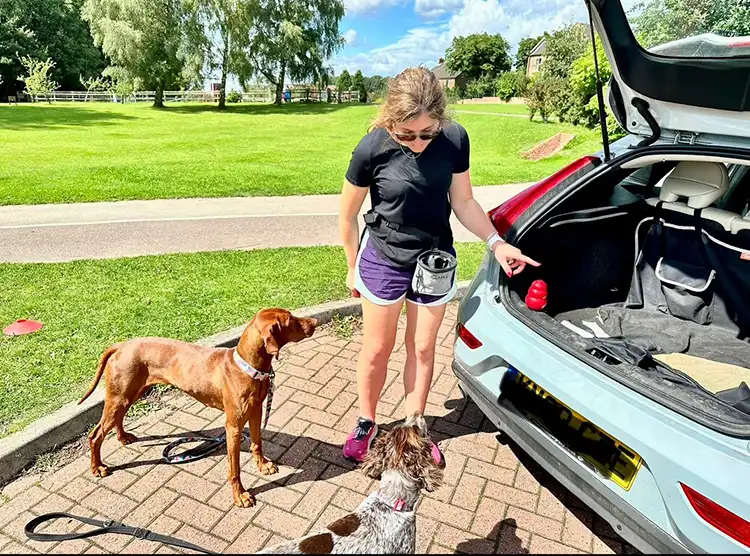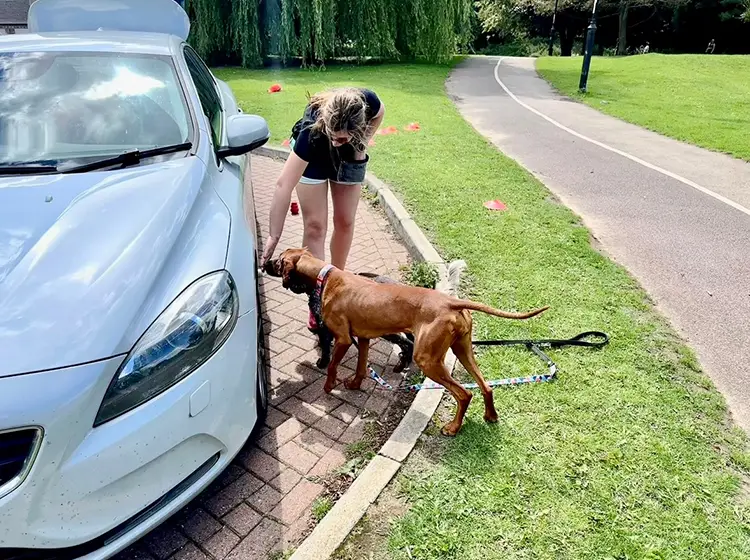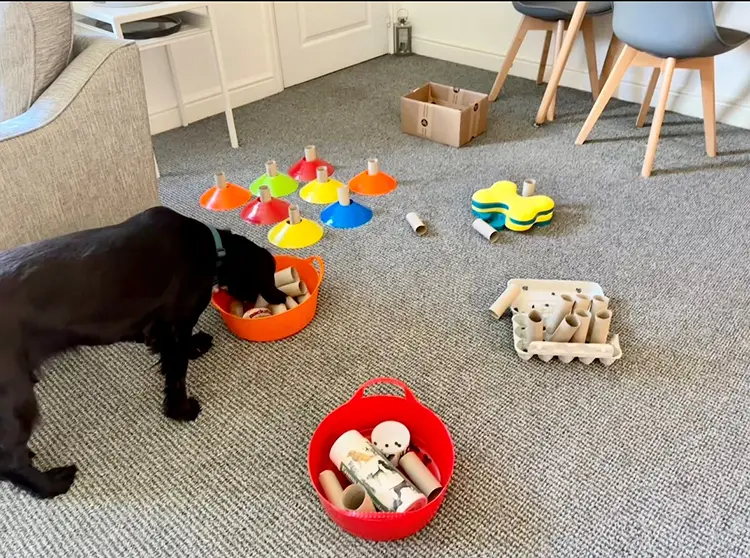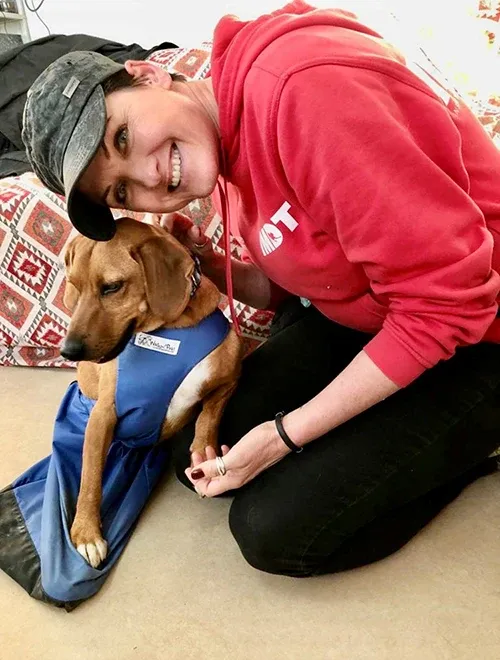Why Physical Exercise May Not Be Enough for Your Dog
Giving your dog a lot of physical exercise may help him become more athletic, but it doesn't address hyperactivity or provide mental stimulation. Rather, instead of over-exercising, this approach works well for stressed-out or even injured pets and helps build strong dog-owner bonds.

STORY AT-A-GLANCE
- Today is day three of bark & whiskers Creating Heathy, Happy Pets Week 2023, and our guest is Jo Woodward, a positive reward-based dog trainer and canine enrichment specialist in North Yorkshire in the U.K.
- In 2011, Jo took in a troubled rescue dog with issues so severe she couldn't live comfortably with Jo's family; it was that little pup who sparked Jo's passion to work with dogs and understand what makes them tick
- Twelve years ago, Jo launched her business, FurryTails, as a daycare, home boarding, and dog walking service; today, FurryTails specializes in dog training and canine enrichment
- Jo believes the foundation of training starts with enrichment, because dogs need to be mentally AND physically stimulated to prevent behavior problems, relieve boredom, foster a sense of calm and confidence, and strengthen the bond they share with their humans
Welcome to day three of bark & whiskers Creating Healthy, Happy Pets Week 2023! This week I'm focusing on the many different aspects of pets' physical, mental, and emotional well-being, and I'll be interviewing a wide range of experts in nutrition, behavior, enrichment, exercise, and physical rehabilitation.
My guest today is Jo Woodward, who is chatting with us from North Yorkshire in the U.K. Jo is the owner of FurryTails, a company that offers positive reward-based dog training and enrichment.
Below are some of the highlights of our discussion, but I encourage you to watch the full interview above for much more detail and information.
Physical Exercise Alone Can't Meet All Your Dog's Needs
Research is showing just how important enrichment is for our animal companions, and I'm very excited to talk with Jo today about how we can focus more on enrichment for the mental, emotional, and physical health of our pets.
Jo started her business, FurryTails, about 12 years ago as a daycare, home boarding, and dog walking service. She realized very quickly that exercise wasn't the only thing dogs needed, and indeed, over-exercising our dogs may create athletes, but doesn't necessarily address, for example, the tendency of some dogs to be "hyperactive."
So, she started working with dogs to keep them mentally stimulated without an excessive amount of exercise. This approach also worked well for dogs with injuries, stressed-out pets, and for helping to build strong dog-owner bonds.
"I wanted to stand out when I started my business," Jo explains. "I wanted to really look at the whole dog rather than being "just" a trainer, or behaviorist, or dog walker. And the results have just been fantastic over the years. People come to me saying, 'My dog is hyper. My dog's dragging me down the road. My dog gobbles their food up really quickly.' I ask them what activities they're doing with their pet, and they think they're doing the right thing by taking three long walks a day and playing ball with them.
I started looking into how this was affecting their brains, how it was affecting their joints, and whether we should just take a step back and look at natural enrichment. There are so many products on the market now that there's enrichment for every dog out there."
Sniffing and Chewing Are Calming Enrichment Activities
I didn't realize until I was doing research for The Forever Dog that smelling things is so important to dogs. I knew they enjoyed sniffing the world around them, but I had underestimated just how important it is to their cognitive health. I asked Jo to talk about some of the benefits dogs derive from exercising their brains as well as their bodies.
"If you think about it, our dogs wake up every day and look to us for everything because we're their everything," Jo says. "If we take them for walks and maybe run around the house playing with them, there are still many hours left each day during which they may be bored. If we overexercise them, they may sleep a lot, but it won't be good quality sleep, and they're still going to have a very active brain.
For me, the very root of training dogs, looking at any behavioral issues such as lack of confidence or being overexcited, is to get them using their brains and slowing them down. Sniffing is a calming activity. There are so many enrichment products available now, like lick mats and snuffle mats, for instance. And natural chews. When we get dogs using their brains, their bodies release lots of endorphins and calming hormones, and we're meeting their needs beyond the physical.
It also helps dogs build independence. So many people are working from home nowadays, but it's not good for dogs to expect to be entertained constantly. We need to offer them enrichment activities to do on their own. And on walks, they don't have to be zooming around everywhere. Instead, keep them close and encourage them to sniff.
I also love scent work because it channels a dog's natural drive to sniff things. About 10 minutes of sniffing is the equivalent of a half hour of walking because a dog's sense of smell is 100,000 times stronger than ours. It tires them out. Let's get them using their brains while staying close to us so we're sharing the experience with them. It really helps to strengthen our relationship with our dogs.
Recently I was working with a very nervous Hungarian Vizsla. She's just over a year old and doesn't like traveling in the car. The owner has to pick her up and put her in there. We've been doing some desensitization work, but during our fourth session, we did some scent work. We moved the target (a Kong) closer and closer to the boot of the car. By the end of the session, oh my goodness, the dog was jumping in and out of the boot of the car. The owner cried, we hugged. It was just a wonderful experience because it got the dog's brain thinking about something else instead of, 'I don't want to go in the car.' She was sitting up and was alert, where normally she's crouched down and drooling.


I also regularly do scent work and brain games with my dog, Sunny. She had major surgery when she was only a year old, and she was on three 10-minute lead walks a day. We managed by doing loads of brain games. She's still on limited exercise because she has an implant, so we go on lovely short walks, we do loads of brain games. I also teach her new tricks."

Enrichment on a Budget
As Jo mentioned earlier, there are lots of canine enrichment products on the market these days, but they can be costly — especially if someone wants several different types to keep their dog engaged. I asked Jo for some options for dog parents on a tight budget.
"Well, if you have a yard, for example, you could scatter some of your dog's food in the middle of the grass," Jo replies. "If you have a garden, you could consider providing an area for your dog to dig. You can teach him that the spot is his by putting some treats and a few toys there. You might also think about a sandpit. For people without a yard or garden, everyone has some recycling, such as cereal boxes, or empty cardboard paper towel or toilet paper rolls, or a plastic milk carton or plastic water bottle. You can take an empty toilet paper roll, place a bit of food or a treat inside, fold the edges down, and let your dog figure out how to get to the snack.
Speaking of snacks, you can also use food. You can hard boil and peel an egg and let your dog push it around on the floor before eating it. You can chop vegetables and scatter them in some cardboard. You can make a snuffle mat if you don't have a lot of money. They're really easy to make. You can find the instructions on YouTube."
Of course, it's important not to use anything your dog might quickly eat, like a plastic bottle or cardboard.
"You really need to keep your dog right in front of you," says Jo. "Always supervise your dog during enrichment activities because we don't want them swallowing anything that could harm them."
Enrichment Can Be a Lifesaver for Dogs With Mobility Issues
Enrichment activities are especially impactful for dogs with mobility issues, perhaps they're paralyzed, or paraplegic, or have degenerative myelopathy, or they're in a cart. There was a time when most of these animals would be euthanized because they had no quality of life, but when a guardian focuses on creating enrichment activities for pets with restricted movement, they can flourish mentally.
"You've touched on a really good point here," says Jo. "In 2019 I was invited to a rescue center in Cyprus to see a beautiful two-year-old terrier named Tommy who had been hit by a car and lost the use of his back legs. The people at the rescue wanted me to help enrich Tommy's life, especially since it was going to be many months before he would have his wheels. He couldn't run around like other dogs and his chances of finding a home were limited, but the rescue wanted to try to give this happy boy the best possible quality of life.
So, I went out there with my bag filled with lots of enrichment toys and tools. We did a big live event, and it was just wonderful. And it wasn't just Tommy that benefited. All the other dogs in the center did as well. Very nervous dogs were curious to come over.

Problem solving engages a dog's brain. Now, we wouldn't give a four-year-old a 50-piece jigsaw puzzle and expect them to just get on with it. We would sit down and do a tiny jigsaw puzzle and encourage them, and then when they've got it right, we would celebrate with them. This approach is also important with dogs. We show them how to problem solve by, for example, simply flicking a piece of kibble across the floor and saying, 'Can you get it?' Then you can start to make the problem harder and harder to solve. For me, even a dog holding a chew because they don't want it slipping away, is them using their brain."
Enrichment Is Also a Canine Confidence-Builder
I rescued a dog that literally grew up in a nursing home. He had never even met another dog, much less been provided any sort of enrichment. His papa died in the nursing home when the dog was 13. The people at the nursing home told me, 'He came as a puppy, and he just sat on his dad's lap, and he never had any chew toys. He never had anything.' So, when I rescued him, he had very few coping skills. He didn't know how to act around other dogs. He didn't know what to do outside. He certainly didn't know what to do with toys and this concept of play, it almost scared him.
The one treat he loves is dehydrated chicken hearts. But if I flicked a piece of dehydrated chicken hearts across the floor, he was like, "What are you doing?" But if I put it down two or three feet from him, he would think, "Okay, I'm going to go over there and get that, but seriously, what are you doing?" It didn't take him very long to realize, "Oh, it's a game!" So, he would play find the chicken hearts around the kitchen and then the living room and then the office. Just watching him develop curiosity as a geriatric dog still makes me cry.
I put a treat under a dish towel, and he was intimidated. He was like, "Oh, it's gone." So, I waited a bit and watched him, and he decided to give it a shot. Then it was like, "Is it okay if I move the dish towel?" I gave him the okay. He's now confident enough that I can scrunch up a bath towel, put some rubber bands on the ends to make an accordion-type thing, put some dehydrated chicken hearts in there, and he'll put his little nose down in it and sniff out those treats. It's wonderful to watch him gain some confidence.
If you'd like to learn more about Jo and canine enrichment topics, you can find her at her FurryTails website, as well as on Facebook and Instagram.











